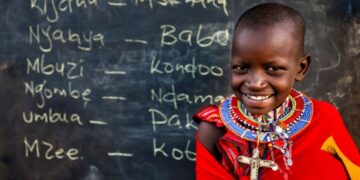The shortest tribe in Africa is the Bambuti of the Ituri forest of eastern Congo. They are divided into 4 groups namely the Sua, Aka, Efe, and the Mbuti, and these names are often interchanged. However, they are mostly called “pygmies”, a name common for a group of adult humans whose height is less than 4 feet 11 inches, or according to anthropologists, “tropical forest forager”.
Even though this tribe leaves away from modern society, they possess an interesting lifestyle and continue to thrive in ancient tradition. Let’s get to meet the African pygmies.
The Origin of Africa’s Shortest Tribe
The Bambuti pygmies according to researchers have been in existence since 6000 years ago. They are one of the oldest indigenous groups within the Democratic Republic of Congo formerly known as Zaire and their lives revolve around the Ituri rainforests. At an average height of 4 feet 6 inches, they hold records as the shortest tribe in Africa.
At present, it is said that at least 20000 pure-blooded Bambuti remain in the world and are scattered across the equatorial band of Africa like Cameroon, Gabon, and the Central African Republic.
What is Responsible For Their Short Statue?
A lot of studies have been carried out to give answers to why these people are short. It is unfortunate that all answers are based on theories and not facts. Better still, no researcher has been able to explain the cause of their short stature.
The first theory presumes that their nutrition and environment could be the cause as they lack enough ultraviolet light levels in rainforests. As such, they lack enough vitamin D that should have converted the calcium from their diet into bones for growth and maintenance. Consequently, they are left with small skeletal sizes since there’s a shortage of low-calcium food and calcium circulation.
However, if the environment was at all the cause for their short status then, what’s there to say about other pygmies living under favorable climate conditions in Bolivia but are still short? Also, if nutrition was the case, how about the Maasai tribe of eastern Africa who do not get enough nutrition yet grow very tall?
Another study links their short stature to low levels of expression of the genes encoding the growth hormone receptor and growth hormone. Well, this has also not been verified.
Another approach suggests that they arrive at puberty very early which is forwarded with reproduction hence growth stops. This school of thought is known as short life expectancy where the energy needed for physical growth is diverted for reproduction.
What Language do they Speak?
Aside from the perplexing lifestyle of the Bambuti tribe, their means of communication have also gained interest. This could be because they have long separated from others. Well, we learned that they speak the Bantu language and Central Sudanic language; a language adopted from the communities that are close to them.
However, in ancient times, these people spoke Bambuti languages which have long gone extinct.
How do the African Pygmies Sustain Livelihood?
Even though these people live in the dark forest and have excluded themselves from the modern world, they still find a way to survive. Most pygmies are nomadic hunters and gatherers. They spend their time hunting the wilds in the forest and also collecting wild fruits like safou, mangoes, and nuts.
When they need crops and grains, they exchanged possessions such as wooden goods and iron goods with neighboring farmers of the Bantu tribe as they do not use money.
The African Pygmies sleep in huts built with branches of Nzon and Mbude trees which are common in the forest. However, these houses are mostly temporary because they move to a new location within 1-3 months when food becomes scarce and when the odor from their waste becomes unbearable.
As for treatment, they use leaves and tree bark while the Nlouer plant is used on their skin against poisoning and dry leaves ashes for tattoos.
Most pygmies believe that their lives are easy and simple as the forest provides for their needs. These people do not believe in the afterlife. As for them, life starts and ends in the heart of the forest.
Read Also: Tall African Tribe; Are The Dinka People The Tallest In The World? 10 Facts
Ceremonial Activities and Marriage of the Shortest Tribe in Africa
Though isolated from the modern world, these tribes are not left out when it comes to ceremonies. Of course, they dance, sing, and get married, and yes in an exciting way. However, the only time they do not dance is when it rains.
Other than marriages, and evening campfires, Nkumbi, the honey feast is one of the most important ceremonies of these tropical forest foragers. This is done after a few days of feasting on honey. The interesting part of this is the dance drama done by women and men.
The women form a circle around a bonfire and the men also form another circle in the opposite direction. It becomes more interesting as the men pretend to seek honey while approaching the ring formed by the women who in turn play the role of bees humming and droning. After a while, the women pick up bonfire sticks and threaten to sting them just like bees while singing the honey bee song, Mafengi.
As for marriage, it is monogamous for this tribe because the population of the men surpasses that of the females. What usually happens is that a married man offers his sister or any female relation he has to his wife’s brother or any of her male relations soon after puberty. Since emotions only play a little role in this, divorce is very common and mostly initiated by women.
The marriage ends once the woman packs her things and returns to her parents’ camp. She could also leave with her children if they are still tender. Nonetheless, the male children return to their fathers once they become old enough to gather food and hunt.
What Religion Do They Belong To?
Since these people have less belief in the afterlife, it is presumed that they do not oblige to any religion. However, they hold strong faith in the forest god called Muungu who according to them provides the goodness of the forest. Aside from this, they also believe in the totemic spirit also known as sitana, and the water animal called nyama. The former are animals whose spirits represent their unity while the latter are gods responsible for serious water accidents.
During very bad climate conditions they practice a magical ritual to delay rain and storm until they are done hunting. Likewise, they engage in molimo rituals when their hunting is unproductive or when they have a special request to make. As such, molimo is their most important ritual.




















